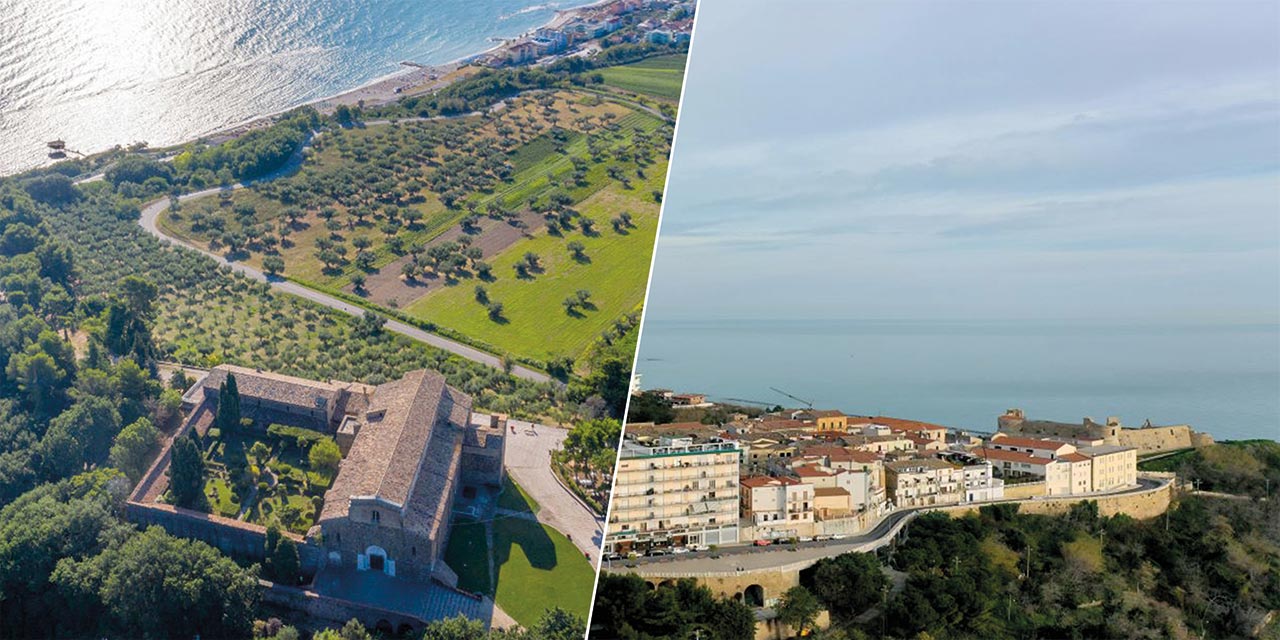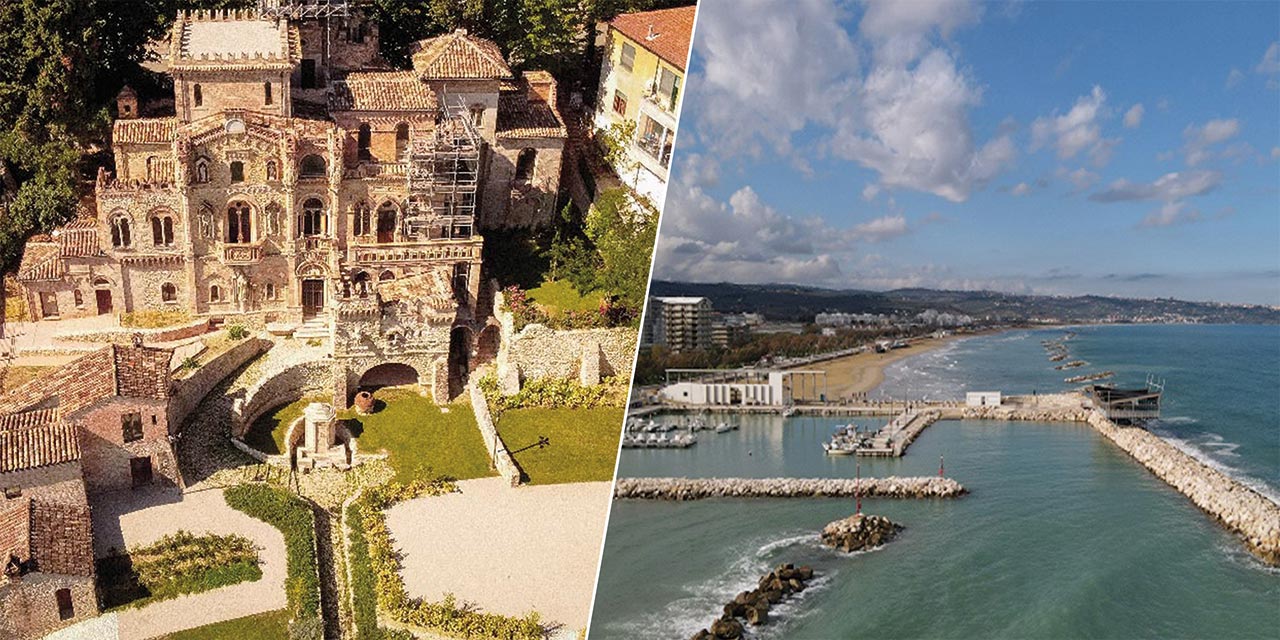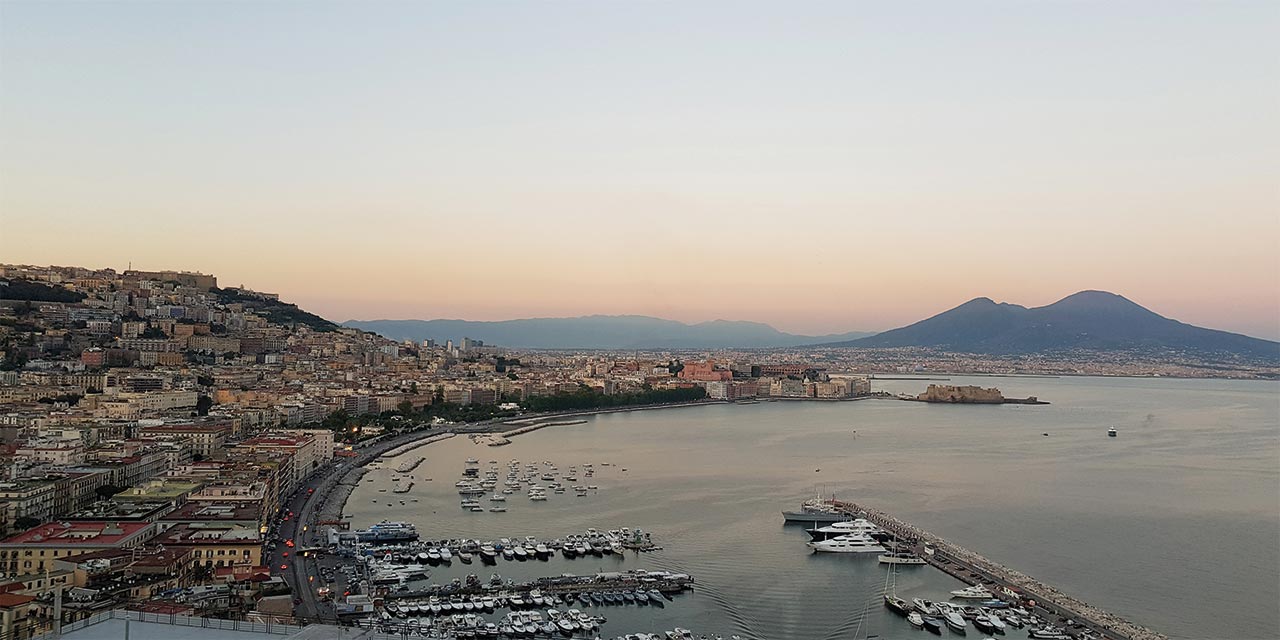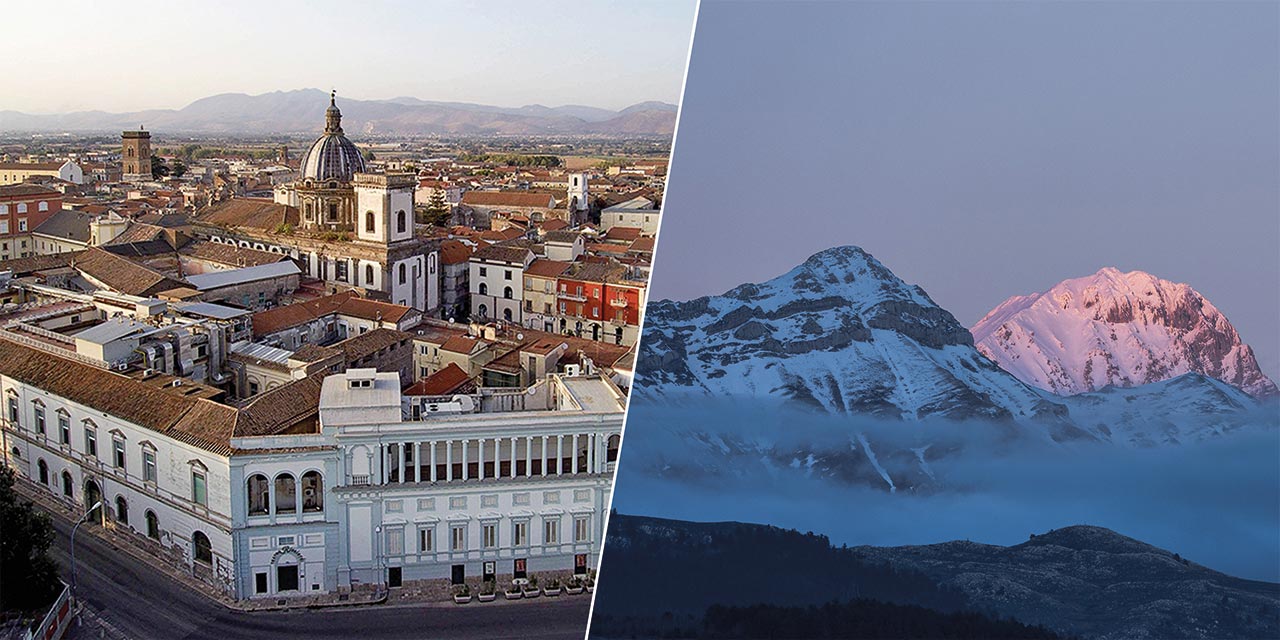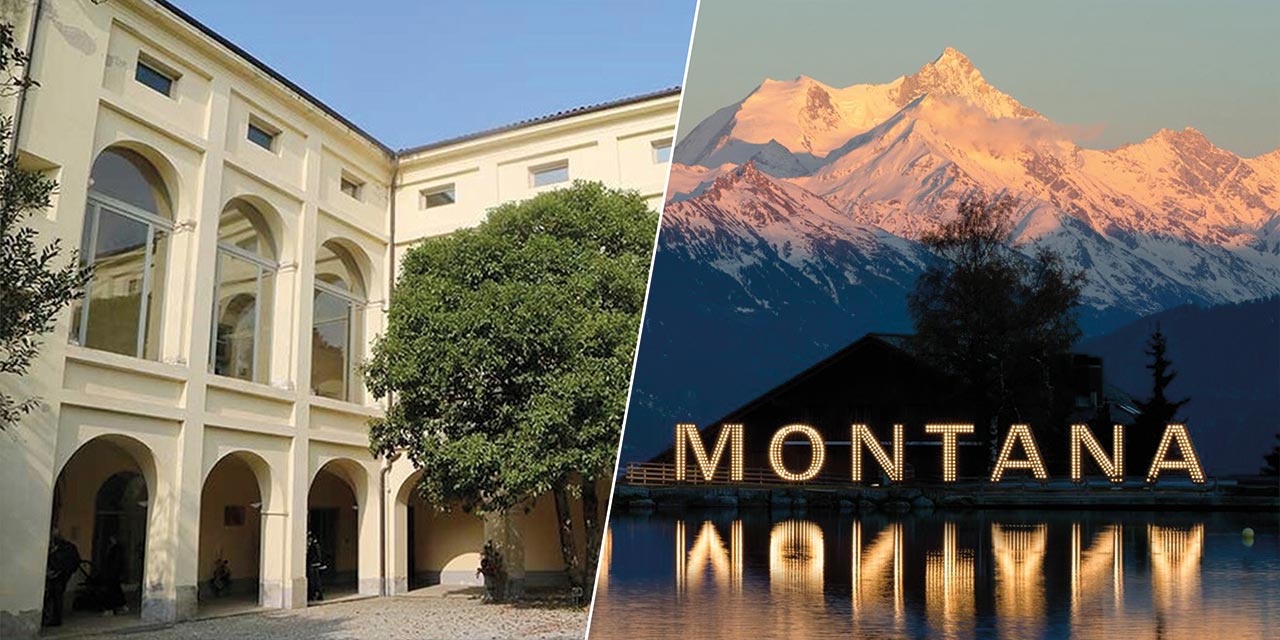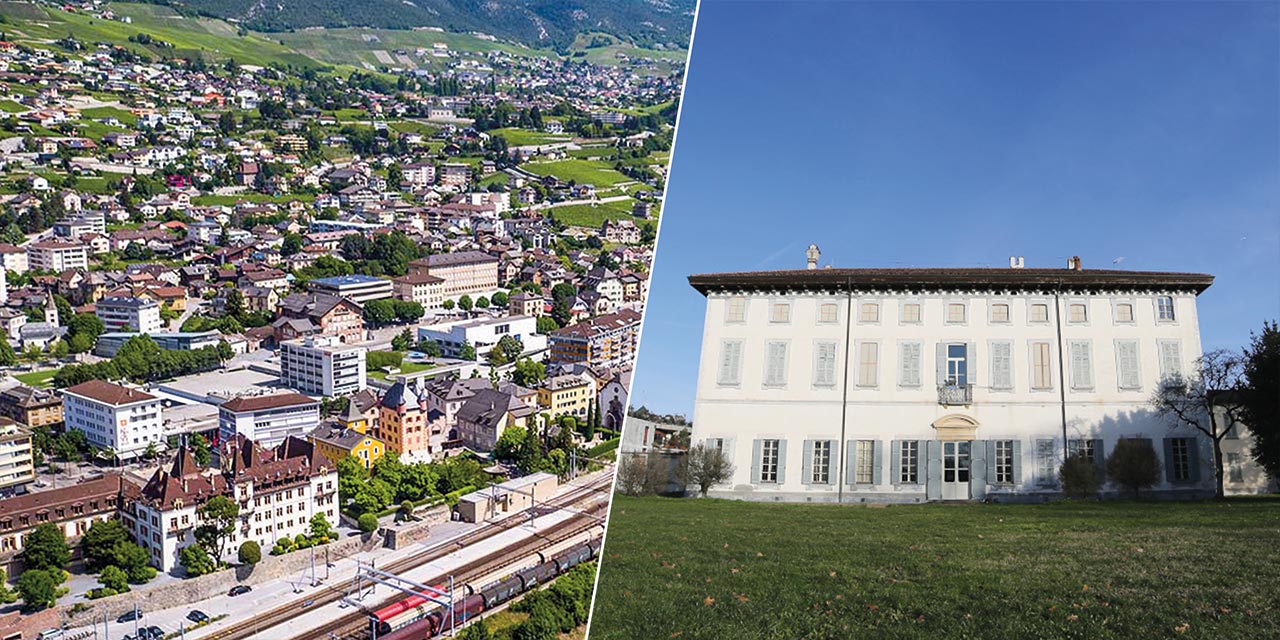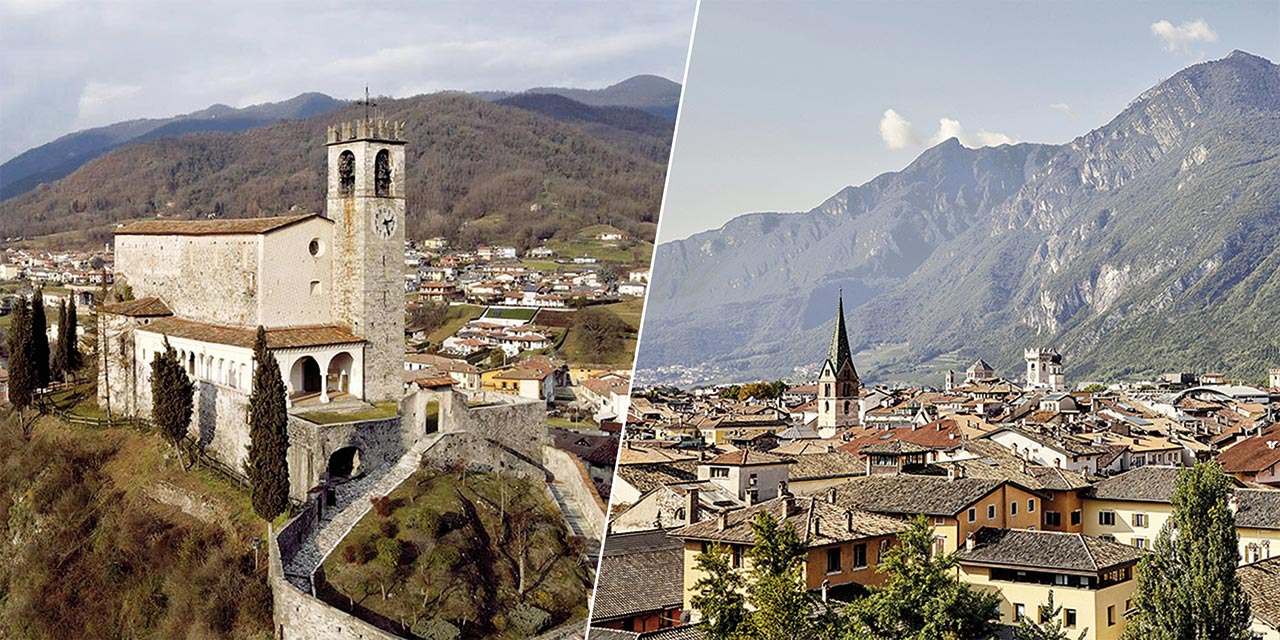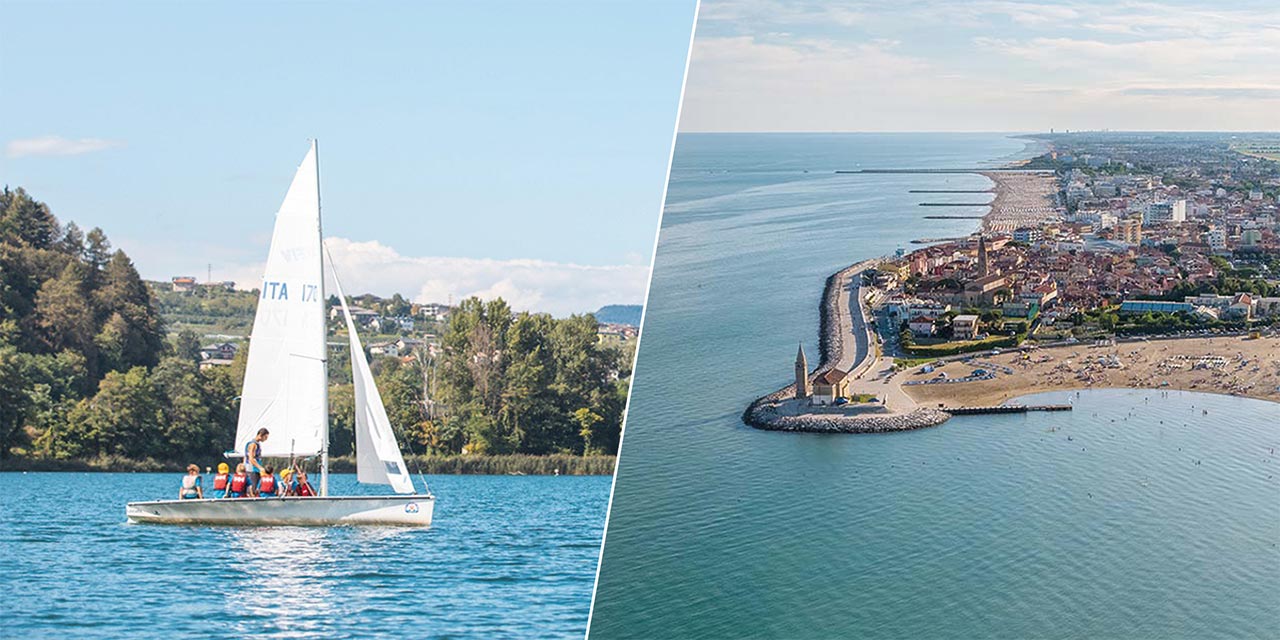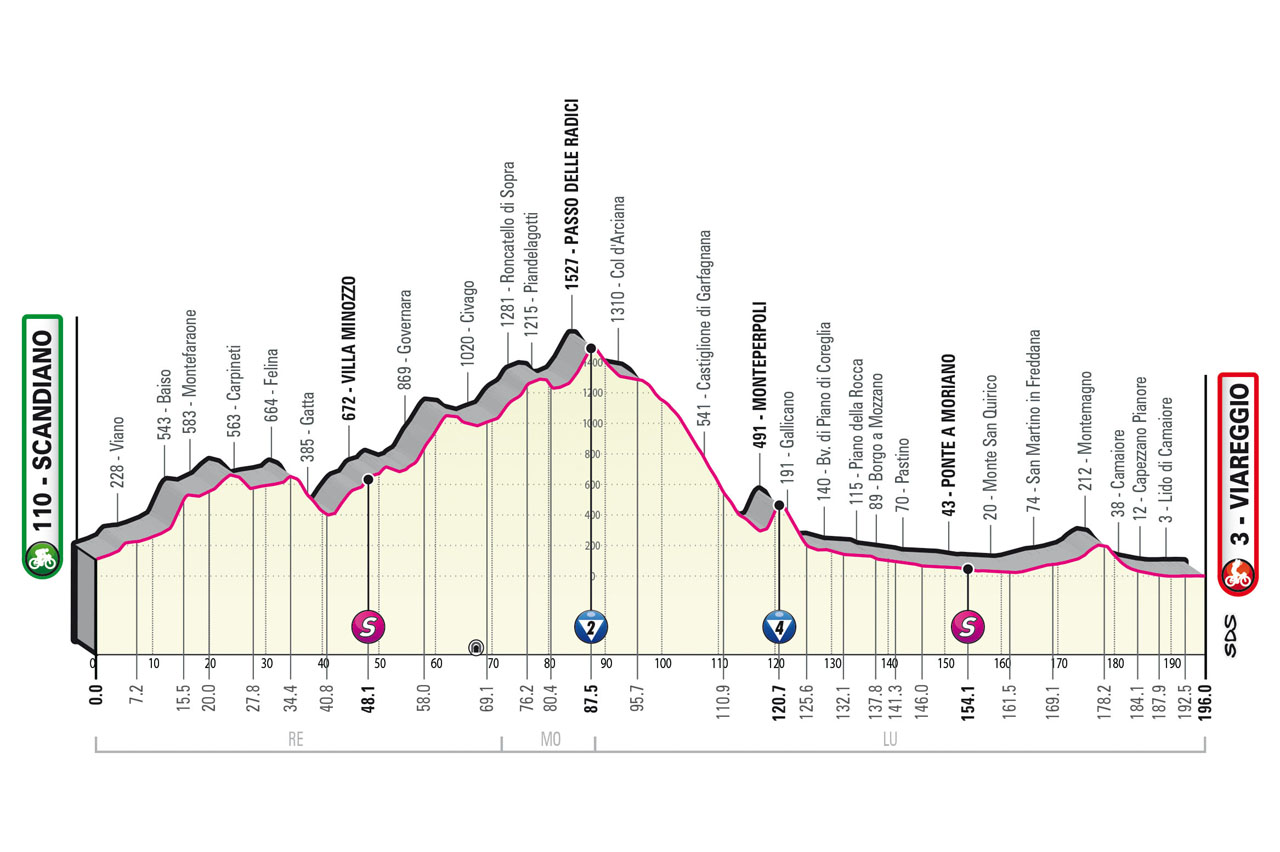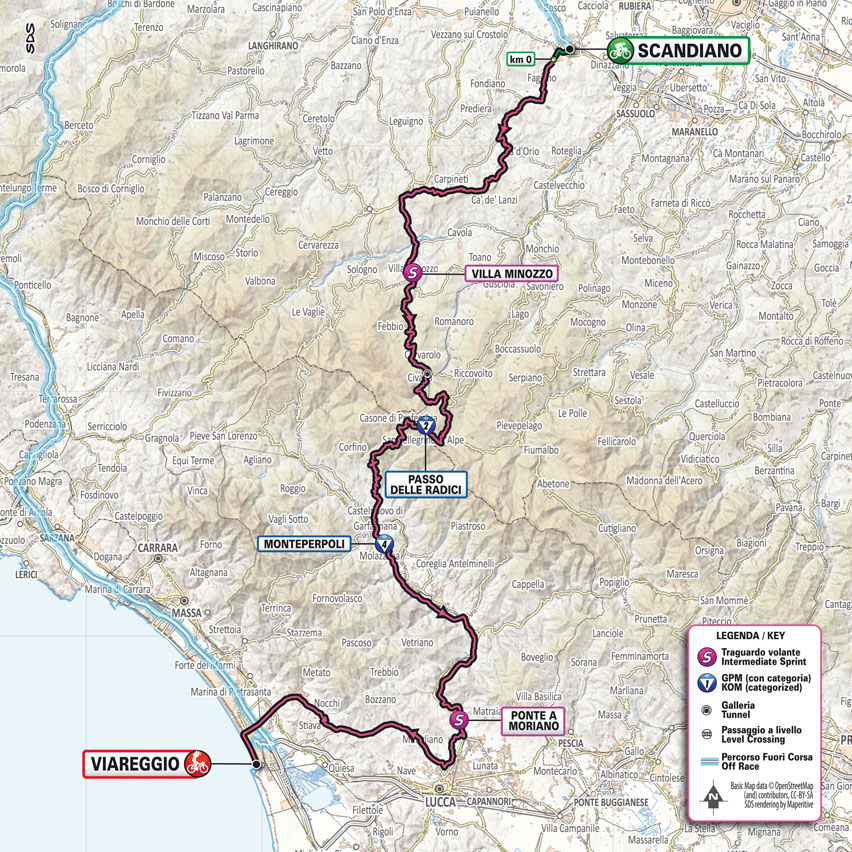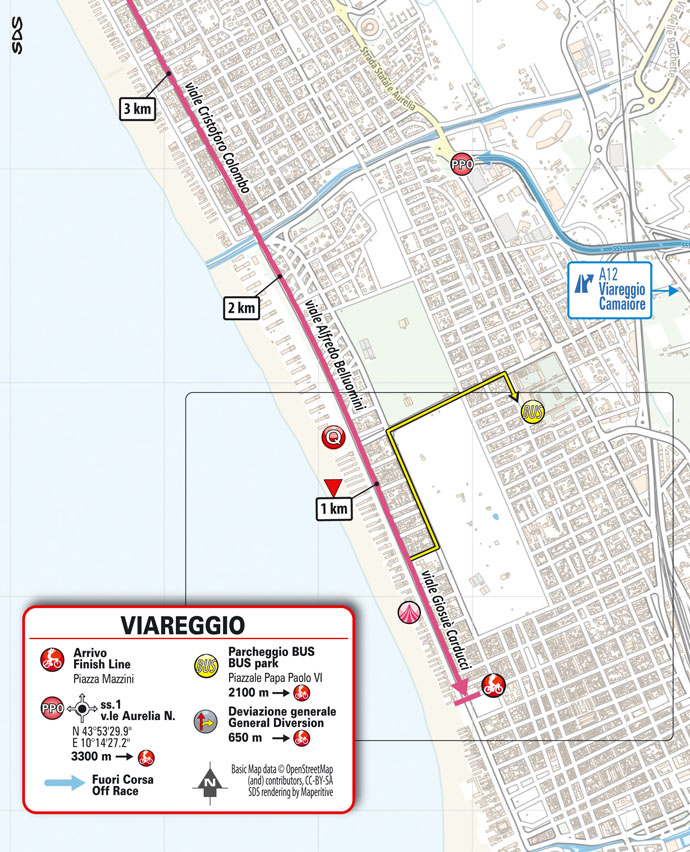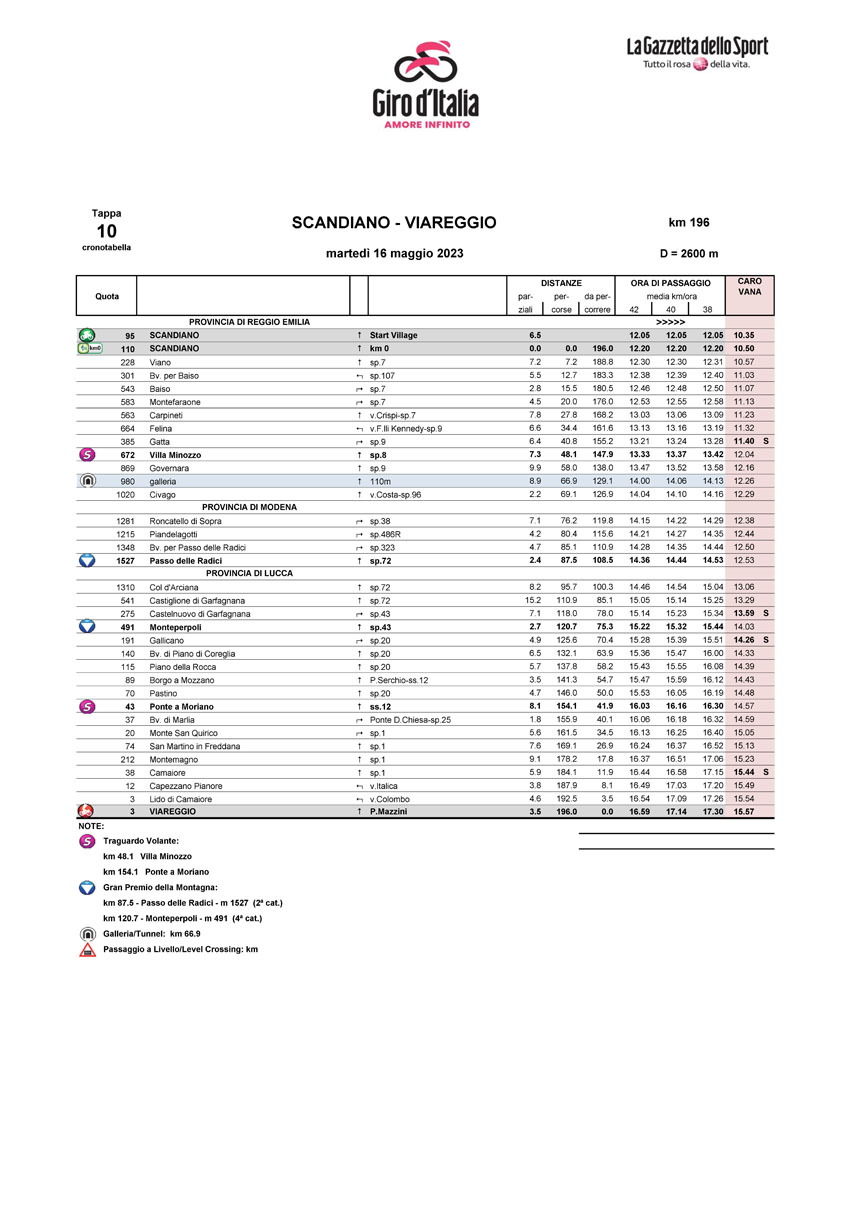profile
map
technical info
A rolling stage that clears the Tuscan Apennines, heading for the Tyrrhenian Sea. Following increasingly longer undulations, the route negotiates the Passo delle Radici climb, which, overall, can be considered almost 40 km long. Except for the last 3 km, the gradients are weak. After a fast‑running and technical descent into Castelnuovo Garfagnana, the route takes in a short climb to Monteperpoli. A long false‑flat down, passing just outside Lucca, leads through Camaiore to the coast, and all the way to the finish.
Final kilometres
The last 3 km run flat and straight along the seafront, from Camaiore to Viareggio. The finish line sits on an 8 m wide tarmac road.
start / finish
final kilometres
itinerary timetable
tourist info
Host city:
Scandiano
Overview
In 1423 Feltrino Boiardo, then-landlord of these territories, obtained the title of “Countship” for his possessions from the Estensi Family. 600 years after that historical date – meaningful to all the inhabitants of Scandiano – the City Government has decided to celebrate this event by participating, for the first time, in the Giro d’Italia 2023 as a host city.
Scandiano is a few kilometres far from Reggio Emilia (the Province capital city), and it is considered an important historical centre developed around the ancient fortress of the Boiardo’s Family called “Rocca”. Its territory includes eleven hamlets: Arceto, Cacciola, Ca’ de Caroli, Chiozza, Fellegara, Jano, Pratissolo, Bosco, Rondinara, San Ruffino and Ventoso. The overall number of inhabitants is approximately 26.000.
Walking in the city centre of Scandiano – chanted in the verses of the poem “A Scandiano” by Giosuè Carducci – means experiencing an “immersion” in the birthplaces of some of the most important Italian historical figures, for instance the author Matteo Maria Boiardo - who wrote his famous epic chivalric poem “L’Orlando Innamorato” (Orlando in love) in Scandiano – or the scientist Lazzaro Spallanzani – considered the “father” of medicine and biology, and known for his experiments in the tower of the fortress, which led to some of the most relevant scientific discoveries of modern times.
Just outside the town centre, Scandiano’s hills offer a breath-taking view over the Spergola vineyards.
Food
Spergola, the perfect match for Emilian cuisine
One could fill lots of books with things about local wine-gastronomy.
The “journey” starts with the king of all the cheeses, the protagonist of the Emilian cuisine. It’s Parmigiano-Reggiano of course, which represents – in home recipes as well as in restaurants’ delicacies – a “guarantee” of goodness.
Parmigiano-Reggiano, the cheese that boasts more attempts at imitation in the world, was born in the heart of Emilia, in the area between two important cities: Parma and Reggio Emilia. It is produced according to strict criteria, which make it an excellent ingredient for many recipes.
With the “Parmigiano-Reggiano” one can prepare the filling for tortelli and cappelletti, two sorts of egg pasta representing the heart of the Emilian and local cuisine.
By pairing this cheese with balsamic vinegar, also known as “black gold”, one can experience a very tasteful combination, sweet and sour at the same time.
Scandiano’s City Government granted the use of a part of the Clock Tower for production purposes to the Confraternita dell’Aceto Balsamico (Balsamic Vinegar Brotherhood – an authority that supervises and safeguards the production of local home-made balsamic vinegar). The vinegar battery (set of barrels), hosted on the top floor of the Clock Tower, is located in the ideal place to make the balsamic vinegar develop its characteristic scents to become a top quality product.
It is impossible to not stop in one of the many bakeries of the town to taste the so called gnocchini: round pieces of flatbread which release an irresistible aroma, especially when just out of the oven.
Another unmissable recipe of this Region is Erbazzone : a savoury quiche made of spinach and beet leaves, seasoning and (of course) Parmigiano-Reggiano, lying between two puff pastry layers.
The Emilian cuisine – traditionally “vocated” to pork meat – includes also many types of cured meat, greaves and rinds, such as cotechino and zampone.
And what’s for dessert-lovers? Some patisseries of Scandiano produce the famous Boiardo’s cake, or Scandiano’s cake, an ancient recipe that is definitely worth a bite, better when served with local wines such as Lambrusco – a sparkling intense red wine with a dry enchanting taste – or Spergola.
Nowadays, taking up the legacy of Scandiano’s Enological Society of the 19th century, the so called Compagnia della Spergola (Spergola’s Society) safeguards the production of this local white wine with strict criteria, and it promotes this unique traditional product through many initiatives.
Wine and beverage
In 1886, in one of his letters to Severino Ferrari, Giosuè Carducci wrote about Spergola: “the renowned and widespread wine of Scandiano that foams like a sea wave and then harmonizes its bouncing rhythms with the joy of those who savour it…”
The first traces of the local viticultural tradition date back to the 11th cent., in the properties of the Countess Matilde di Canossa, Vicereine of Italy. The legend tells the Countess gave some of this white wine to Pope Gregorio VII as a gift. In the 16th century, Bianca Cappello, Grand Duchess of Tuscany and wife of Francesco I de Medici, mentioned “the good, fresh, sparkling wine” of Scandiano in her travel memoirs.
Points of interest
Mentioning Scandiano’s most important places, it’s impossible not to start with the Boiardo’s fortress, our “Rocca”. Being the city’s presentation card, this monumental complex dates back to the early 14th cent. It can be said – with no doubt – this monument has an important historical and cultural value: it was built by the Da Fogliano, a noble family of the Italian Renaissance, but it owes its name to the Boiardo’s Family, who lived here for 137 years (from 1423 to 1560). Being initially built for military defence purposes, it is surrounded by walled enclosures with a moat, a drawbridge and watchtowers.
The parish church dedicated to the Virgin Mary stands in front of the fortress’ entrance. It hosts the Boiardo’s tombs, Spallanzani’s cenotaph, and it is embellished by remarkable works of art, such as the Baroque presbytery and the chapel of Saint Catherine, who is one of the patron Saints of the town.
Continuing from Piazza Boiardo (Boiardo square) to Via Magati (Magati street), one can easily reach the native house of Lazzaro Spallanzani.
He was born in this manor on Jan. 12th 1729. Here it is where he lived for a long period of time, made new discoveries and established a rich natural history museum on the second floor. The building was declared “national monument” in 1939.
At the end of Via Magati there is the Civic Tower, also known as the “Clock Tower”. Originally it was the main access gate to the ancient district, built by the will of Feltrino Boiardo in the first half of the 15th cent. In 1548 the clock had already been placed on the tower, and it could be admired from the nearby market place. The bell was blessed by Pope Paolo III in 1543.
Close to the Clock Tower, Piazza Fiume (Fiume square) opens with its typical colourful façades, once belonging to the Jewish Ghetto of Scandiano (later demolished with the Synagogue).
Walking from Piazza Fiume to Corso Garibaldi (Garibaldi Bvd.) one gets to Piazza Spallanzani (Spallanzani square), with the statue of Lazzaro Spallanzani standing in the middle of it. Taking Corso Vallisneri (Vallisneri Bvd.), the Townhall stands to the right, and, a little further on, to the left side, San Giuseppe Church, a small treasure of Baroque architecture.
Leaving the historical city centre, a pleasant walk on Scandiano’s hills leads the visitors to the Spergola’s vineyards, where this local grape variety becomes a unique sparkling white wine.
Breath-taking views and suggestive glimpses are offered by the iconic Monte delle Tre Croci (Three Crosses Hill), a “terrace” overlooking the city which is very appreciated by the locals. From its top, on clear days, one can admire some of the most beautiful sunsets of the whole area and, given its steep slopes, this hill is also a popular destination among cyclists.
Another attraction is the Grande Quercia (Big Oak), a charming monumental tree that dominates the area of Rondinara, one of Scandiano’s hamlets. It can be reached using the homonymous walking/cycling trail.
Moving from Scandiano towards the Via Emilia, Arceto (Scandiano’s biggest hamlet) is worth a stop. The Bishop’s Castle, located in the middle of the village, represents an example of a well-kept medieval castle, where the geometrical spaces once occupied by the moat and the walls are still presumable, as well as the tower and the drawbridge.
The traditional Fair of Saint Joseph – one of the most important events in Scandiano – takes place every year around Mar. 19th, the patron Saint’s day.
It is characterized by an agricultural, commercial and industrial exhibition, a big fun-fair, a street-market and dozens of initiatives related to the event.
As for culture, FestivaLOVE is the absolute protagonist of Scandiano’s spring/summer season. It embeds talks, interviews, concerts, presentations, lectio magistralis, exhibitions and performances of many genres. Every year – usually in the last week of May – this event attracts thousands of visitors under the big “umbrella” of Love, the “trademark” of the territory that inspired Matteo Maria Boiardo for his famous poem “L’Orlando Innamorato” (Orlando in love).
Viareggio
Overview
Viareggio is mainly seen as a seaside resort because a long, sandy beach bathed by the waters of the Mediterranean flanks the town. However, it can also boast close proximity to the mountains of the hinterland, the Lake of Massaciuccoli and the protected areas of the Park of Migliarino and San Rossore. The town plays host to a number of national and international cultural and sporting events throughout the year including the Viareggio Carnival, which this year celebrates its 150th anniversary, the Puccini Festival, the Rèpaci Literature Prize and the Viareggio Cup World Football Tournament.
The warm, at times dazzling, spotlight of Viareggio sweeps across the sea to the profusion of traditional bathing establishments lining the beach and the déco architecture of the promenade and continues over the bridge before arriving in the fishing harbour. From the pier, it runs along the Burlamacca canal linking the town centre and the suburbs and reaches the dockyard home of shipyards that are renowned for building some of the most beautiful yachts in the world. And then to Torre del Lago and the home of Puccini by the lake, where the silence and stillness of the water are only occasionally disturbed by the swish of an oar or the sound of birdsong to reveal the secrets of residences from a bygone era. A glimpse of urban and seafaring life set against a backdrop that truly inspires.
Food
Traditional dishes that must be tried during a stay in Viareggio
Pasta alla trabaccolara
“Trabaccolara” is a traditional Viareggio dish made using fish that hasn’t sold at the market. The name derives from the lugger, “trabaccolo”, used by the fishermen from San Benedetto del Tronto, some of whom moved to Viareggio between the 1920s and the end of the 1930s. Fish such as gurnard, scorpion fish and weever are needed to prepare the dish, to which some cooks add shellfish (although not part of the traditional recipe). The fish is cooked with tomatoes and flavoured with wine and aromatic herbs.
Risotto with squid and chard
This risotto unites the flavours of the land and the sea and is a favourite served by the local festival street kitchens during the Carnival period. To prepare the risotto, brown the squid, add the chard cut into strips and, once this has softened, add the rice and continue until the rice is cooked; finish the dish with the chopped parsley. Buon appetito!
Viareggio style “Cacciucco”
Strictly with the double “C”s! A simple, traditional fishermen’s dish, this fish stew has been made since the 1500s. Cacciucco, from the Turkish “kuchuk” meaning “small”, would be prepared by fishermen as they returned to port from a fishing trip. The distinguishing feature of Viareggio cacciucco is that it uses the fish of little market value and which the fishermen on landing their catch would otherwise have discarded. To be served accompanied by toasted home made bread, preferably rubbed with garlic. Cacciucco fish stew has a strong and slightly spicy flavour.
Spaghetti “con i nicchi”
So what are “nicchi”? Nicchi are what people from Viareggio call the clams or cockles found on sandy seabeds. They are cooked very simply but are extremely tasty. After purging the “nicchi” of sand by placing them in a bowl of seawater for at least 12 hours, they’re sautéed in a frying pan before adding freshly cooked spaghetti. White wine, garlic and chilli pepper are used to flavour the clams and parsley is added as a final touch.
Spaghetti “con i coltellacci”
“Coltellacci” in Viareggio vernacular are otherwise known as razor shells, which owe their name to the elongated, knife-like form of these molluscs that are found along the shoreline and on rocks after storms at sea. They are prepared plain or with the addition of tomatoes and have a strong, intense flavour.
“Scarpaccia”
Finally, a dessert that isn’t sweet at all but which is usually eaten not only at the end of a meal but also as a snack during the day. A cake featuring finely sliced courgettes as the main ingredient. The resulting flavour, a mixture of sweet and savoury, delights the taste buds. Discover it for yourself!
Points of Interest
The Promenade
The Promenade of Viareggio, one of the most evocative and fascinating places of the Versilia Riviera, features the work of Alfredo Belluomini and Galileo Chini in the many prestigious art nouveau and déco buildings. Extending for 3 kilometres, locals, holidaymakers and visitors from around the world come to enjoy the quintessential holiday atmosphere of the “Passeggiata”.
The Palazzo delle Muse
Originally established as a Thalassic Hospice, in 1912 it became a permanent convalescence home for treating those suffering from tubercular diseases and also to make the benefits of a stay by the sea available to those in need. Today the building houses the municipal library, archive and the Gallery of Modern and Contemporary Art, which, offering an overview of twentieth century Italian and wider European art, is recognised as one of the most specialised galleries in Italy.
The Torre Matilde
The history of the Torre Matilde coincides with that of Viareggio and is an example of 16th century military architecture. As the silent guardian of the coast, the tower bears witness to the centuries of development of the surrounding area. After changes in fortune and use, it is now the venue for cultural events and temporary exhibitions.
The Museo della Marineria
The Museum was founded in order to display finds related to the maritime history of Viareggio and beyond. It is divided into sections dedicated to on-board equipment, shipyards, seafarers and shipwrights and caulkers.
The Casa Museo Giacomo Puccini
The house, transformed into a museum in 1925 by Puccini’s son Antonio, has remained unchanged over time and offers the opportunity to experience the atmosphere of the place where the Maestro found inspiration for his opera masterpieces.
The Villa Museo Paolina Bonaparte
The villa of Princess Pauline Bonaparte was built in 1822 on the seashore on what was then the northern edge of Viareggio to plans by the architect, Giovanni Lazzarini, for a small, secluded residence offering privacy and direct contact with nature. The Villa now houses temporary art exhibitions and is a venue for cultural events.
The Villa Borbone
Villa Borbone is certainly one of the most fascinating historical places in Viareggio. Situated in one of the many appealing parts of the Versilia Riviera along an avenue of lime trees, the “Viale dei Tigli”, the Villa has been restored for use as a multipurpose space by the Municipality and also forms the entrance to the beautiful Regional Park of Migliarino, San Rossore and Massaciuccoli. In the summer season the Villa hosts musical events, cultural festivals and theatrical performances.
The Shipyards
Viareggio is the heart of one of the most significant shipbuilding areas in Italy and is the spearhead of the region’s shipyard supply chain, which is geared to superyacht construction and services, comprising 5,000 companies and directly employing approximately 18,000 workers. With a turnover of 2 billion Euros and 95% of clients for superyachts coming from overseas, the area accounts for 50% of Italy’s revenue from this sector. The local economy linked to pleasure boating involves a wide variety of concerns, professions and trades and over 70 occupations ranging from industry to tourism. Viareggio is home to approximately 1,300 companies that are fully operational in the pleasure boating industry, with a workforce of 8,000 employed in shipbuilding, subcontracting, services and repairs, trade and rental and in the port area. 10 of the world’s leading shipbuilding brands have their headquarters in Viareggio.











